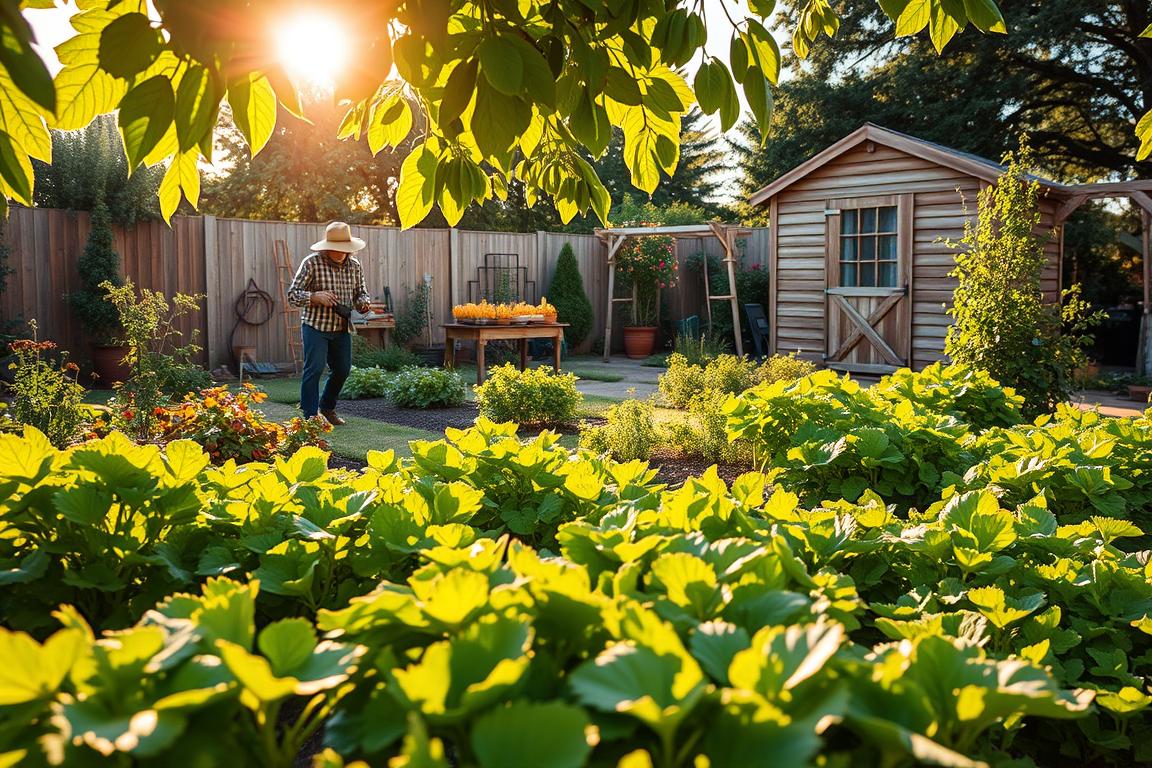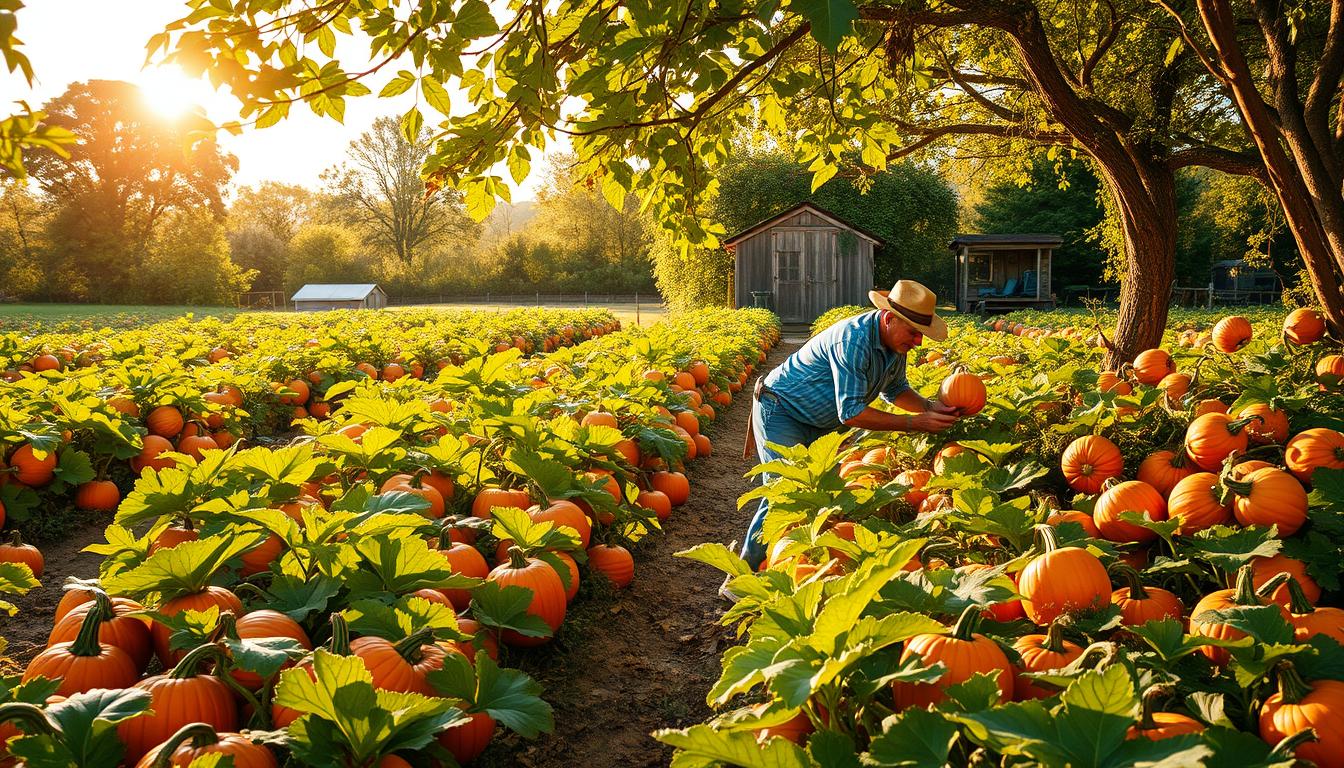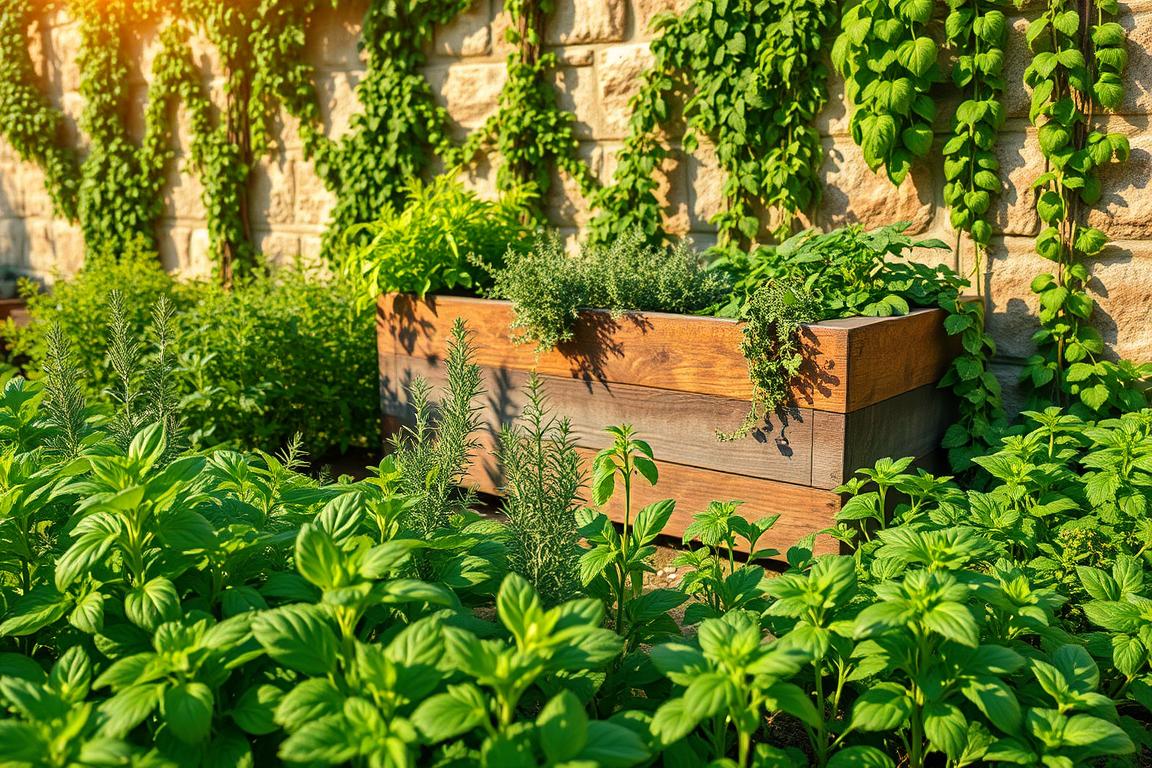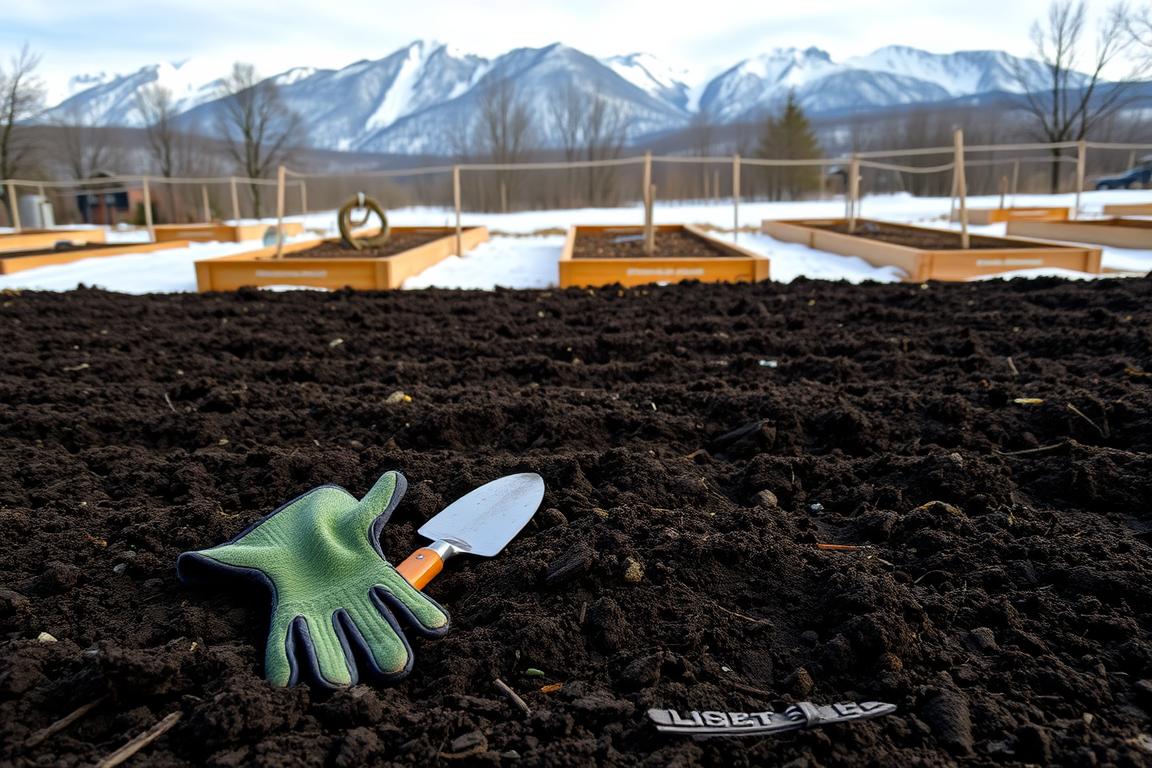Starting a garden from scratch is rewarding. It brings fresh produce right to your backyard. Peter Sandercock, a gardening expert, says to start small. Choose a spot that gets lots of sunlight and drains well.
As a beginner, patience and attention to your garden are key. These simple tips will help you enjoy a rich harvest. Whether you need backyard gardening tips or help with beginner vegetable gardening, starting small is crucial for a thriving garden.
Key Takeaways
- Choose a sunny location for your garden
- Ensure the site drains well to prevent waterlogged soil
- Start small to avoid feeling overwhelmed
- Be patient and attentive to your garden’s needs
- Enjoy the process of nurturing your garden from scratch
Why Growing Your Own Vegetables Is Worth the Effort
Growing your own vegetables can change your life. It’s good for your health, your wallet, and the planet. A backyard garden brings many benefits, more than just the joy of gardening.
Health Benefits of Home-Grown Produce
Home-grown veggies are packed with nutrients and antioxidants. They can make you healthier and happier. With fresh veggies from your garden, you can eat healthier.
Research shows eating fresh produce lowers the risk of heart disease and diabetes.
Economic Advantages of Backyard Gardening
Growing your own veggies can save you money. It cuts down on grocery bills. You also get to enjoy the fruits of your labor.
If you have extra, you can sell it. This can be a way to earn money, selling to neighbors or at farmers’ markets.
Environmental Impact of Growing Your Own Food
Backyard gardening is great for the environment. It reduces your need for industrial farming, which harms the planet. It also cuts down on transportation, lowering your carbon footprint.
Choosing to garden at home is a step towards a greener, more sustainable life.
Assessing Your Garden Space and Conditions
Knowing your garden’s unique conditions is crucial for a successful vegetable garden. Before planting, evaluate several key factors. These will affect your garden’s success.
Evaluating Sunlight Exposure in Your Yard
Most vegetables need at least 6 hours of direct sunlight daily. To check if your garden gets enough sunlight, watch the area all day. Note where it’s sunny and where it’s shaded.
Understanding Your Climate Zone and Growing Season
Your local climate zone and growing season are important. They help decide which vegetables to grow and when. Use online resources or talk to local gardening experts to learn about your climate zone and frost dates.
Measuring and Mapping Your Available Space
To use your garden space well, measure and map it. Use graph paper to draw a scale map of your garden. Include any features like trees or paths.
Considering Water Access and Drainage
Good water supply and drainage are key for a healthy garden. Make sure you have a reliable water source. Also, design your garden to avoid waterlogging.
| Factor | Considerations |
|---|---|
| Sunlight Exposure | At least 6 hours of direct sunlight |
| Climate Zone | Understand local frost dates and growing season |
| Available Space | Measure and map garden area |
| Water Access and Drainage | Ensure reliable water supply and prevent waterlogging |
By carefully assessing these factors, you can create a well-planned and productive vegetable garden. It will meet your needs and give you a great harvest.
Planning Your Vegetable Garden Layout
A well-planned garden layout is key to a successful vegetable garden. It makes the most of space, boosts productivity, and cuts down on upkeep.
Traditional Row Gardens vs. Raised Beds
You have many options for garden layouts. Traditional row gardens are a timeless choice. But raised beds offer better drainage and soil warmth, which can lead to higher yields.
Container Gardening for Limited Spaces
If you have little space, container gardening is a great option. It’s flexible and works well in small or odd-shaped areas.
Creating Efficient Garden Pathways
Good garden pathways are essential for easy access and upkeep. They should be wide enough for easy walking and made from easy-to-clean materials.
| Garden Type | Space Requirement | Maintenance Level |
|---|---|---|
| Traditional Row Gardens | High | High |
| Raised Beds | Medium | Medium |
| Container Gardening | Low | Low |
Using Garden Planning Tools and Apps
Garden planning tools and apps can make designing your garden easier. They help you see your layout and make changes before you start.
Essential Tools and Materials for Beginning Gardeners
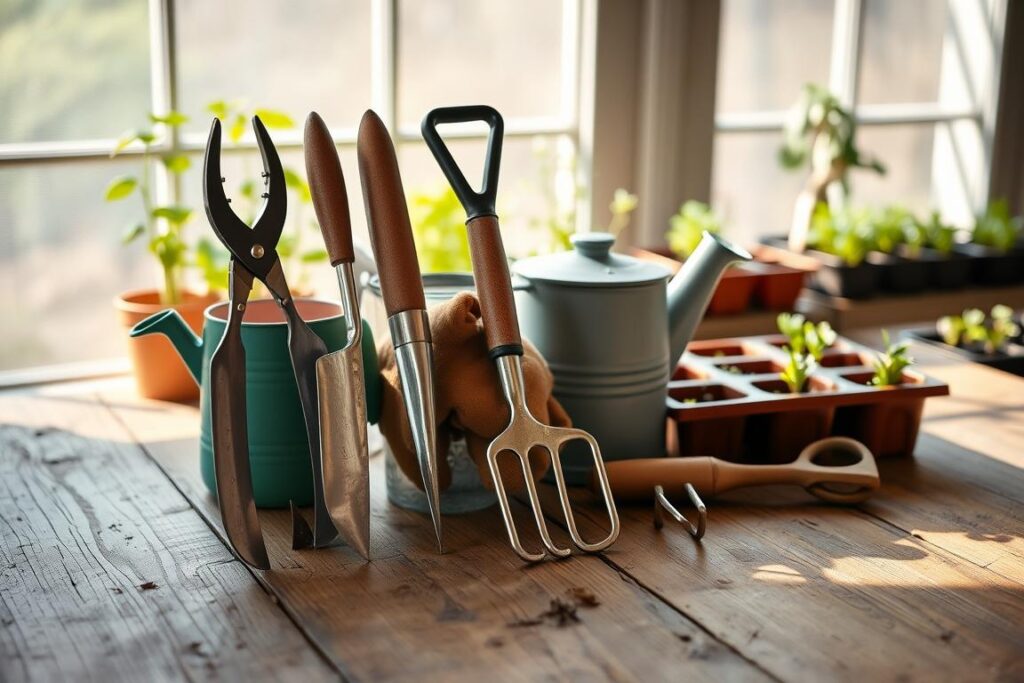
Starting a backyard vegetable garden needs some key tools and materials. As a beginner, getting the right equipment is key for a good harvest.
Basic Hand Tools Every Gardener Needs
Every gardener should have a set of basic hand tools. This includes a shovel, garden fork, trowel, and pruners. These tools help with planting, weeding, and harvesting.
A garden fork is great for turning over soil. Pruners are perfect for trimming plants.
Garden Containers and Raised Bed Materials
Garden containers and raised bed materials are crucial for a productive garden. You can choose from wood, metal, or plastic for raised beds, based on your taste and budget. Containers are good for plants that need better drainage or for extra growing space.
Mulch, Trellises, and Support Structures
To keep your garden healthy and productive, think about using mulch, trellises, and support structures. Mulch keeps moisture in and weeds out. Trellises support climbing plants.
Where to Find Affordable Gardening Supplies
You can find affordable gardening supplies at local hardware stores, gardening stores, or online. Look for sales or use coupons to save money. You can also use old pallets or containers to make garden beds and planters.
How to Start a Backyard Vegetable Garden from Scratch: Step-by-Step Process
Starting a vegetable garden in your backyard needs a clear plan. Follow a step-by-step guide to make sure your garden is well-planned and executed.
Clearing and Preparing Your Garden Site
The first step is to clear the area of debris, weeds, or obstructions. This gives you a clean start. Till the soil to 8-10 inches deep to loosen it and remove clods or rocks. This also aerates the soil, helping roots grow.
Building Raised Beds or Preparing In-Ground Plots
Choose between raised beds or in-ground plots. Raised beds drain better and warm up faster, good for some plants. If you build raised beds, use untreated wood or composite to avoid soil contamination.
Setting Up Garden Borders and Pathways
Set up your garden’s borders and pathways for easy access. Use wood, stone, or gravel for pathways. This improves looks and keeps your garden tidy.
Installing Irrigation Systems
A good irrigation system is key for your garden. Use drip irrigation or soaker hoses to save water. This ensures plants get the right water without too much.
By following these steps, you can make a productive backyard vegetable garden. Remember, planning and care are the keys to success.
Understanding Soil: The Foundation of a Successful Garden

Soil is key to a thriving garden. Knowing about soil is vital for a good harvest. As I explore backyard vegetable gardening, I see how soil quality affects garden health and output.
Testing Your Soil Quality and pH
Before you start improving your soil, test its quality and pH. You can buy a soil testing kit or send a sample to a lab. This step lets you know what nutrients and pH levels your soil has, guiding your amendments.
Amending Soil for Optimal Plant Growth
After getting your soil test results, start improving your soil. Adding compost or well-rotted manure can make your soil better. If your soil is too acidic, lime can help balance the pH. As compost expert Rhonda Sherman says, “Compost is a gardener’s best friend because it provides nutrients, improves soil structure, and supports beneficial microbes.”
“The quality of your soil directly affects the quality of your crops. By understanding and improving your soil, you’re laying the groundwork for a successful garden.”
Creating and Using Compost in Your Garden
Compost is crucial for a healthy garden. It gives essential nutrients and helps soil hold water better. To make compost, mix “green” materials like kitchen scraps and grass clippings with “brown” materials like dried leaves and straw. Turn the compost pile often to help it break down well.
Dealing with Challenging Soil Types
Some gardeners struggle with clay or sand soils. Clay soils can be dense and waterlogged, while sandy soils drain too fast. To fix these problems, add organic matter to improve soil structure. For clay soils, compost helps with drainage. For sandy soils, compost adds water-holding capacity.
Selecting the Right Vegetables for Beginners
Starting a backyard vegetable garden? Choose easy-to-grow veggies. Beginners want a successful harvest without feeling overwhelmed by too many options.
Easy-to-Grow Vegetables for First-Time Gardeners
Beginners should grow tomatoes, leafy greens like lettuce and spinach, and radishes. These are simple to grow and need little care. Tomatoes are a favorite because they’re versatile and easy to grow.
Understanding Plant Families and Companions
Knowing about plant families and companions helps your garden thrive. For example, tomatoes, peppers, and eggplants belong to the Solanaceae family. They grow well together and face similar pests. Planting marigolds with tomatoes can also help keep nematodes away.
Choosing Between Seeds and Seedlings
Do you start with seeds or seedlings? It depends on your climate, time, and how much care you want. Seeds give you more control, but seedlings get a head start. For beginners, seedlings are often easier.
Planning for Seasonal Rotations
Seasonal rotations are key for a continuous harvest and to avoid pests and diseases. Change the veggies in your beds or containers with the seasons. For example, grow leafy greens then tomatoes or peppers.
| Vegetable | Season | Days to Harvest |
|---|---|---|
| Tomatoes | Summer | 60-90 |
| Leafy Greens | Spring/Fall | 20-40 |
| Radishes | Spring/Fall | 20-30 |
Planting Techniques for Maximum Success
Learning how to plant is key for a great backyard garden. The way you plant seeds or seedlings affects their growth and how much they produce.
Proper Seed Planting Depths and Spacing
Planting seeds at the right depth and spacing is crucial. Proper spacing stops overcrowding, which helps avoid diseases and pests. For instance, carrots need to be planted ¼ inch deep and ¼ inch apart. Beans, on the other hand, can go deeper and farther apart.
Transplanting Seedlings Without Shock
When moving seedlings, do it gently to prevent shock. This means hardening off the seedlings before moving them to bigger containers or the garden.
Succession Planting for Continuous Harvests
Succession planting means planting small batches of seeds every few weeks. This method keeps your harvest going all season long.
Vertical Growing Techniques to Maximize Space
For those with little space, vertical gardening is a smart choice. Using trellises, wall planters, or other systems can greatly boost your yield.
By using these planting methods, you can make your backyard garden a success. And you’ll get a lot of fresh produce to enjoy.
Watering and Fertilizing Your Garden
To keep your garden healthy and productive, it’s key to know how to water and fertilize. Proper care ensures your plants get the nutrients and moisture they need to grow well.
Understanding Different Plants' Water Needs
Each plant needs different amounts of water. For example, leafy greens like consistent moisture. On the other hand, tomatoes and squash need more water as they grow fruit. Knowing these needs helps plan your watering schedule.
Setting Up Simple Irrigation Solutions
Simple irrigation solutions like drip irrigation or soaker hoses save water. These systems water plants at the roots, cutting down on evaporation and runoff.
Organic Fertilizing Methods and Schedules
Organic fertilizers like compost or manure boost soil fertility without harming the environment. A fertilizing schedule based on your plants’ growth stages ensures they get nutrients when they need them.
Water Conservation Techniques for Gardeners
Water conservation techniques like mulching around plants help keep soil moist. Also, using drought-tolerant plants in areas with less water makes your garden more resilient.
Mastering watering and fertilizing techniques greatly improves your garden’s health and productivity. Good garden care involves understanding your plants’ needs, using efficient irrigation systems, and applying organic fertilizers.
Troubleshooting Common Garden Problems
Finding and fixing garden problems early is key to avoiding bigger issues later. Even with the best planning and care, gardens face many challenges.
Managing Garden Pests
Pests like aphids and slugs can harm plants a lot. To fight these pests, I mix different methods. This includes bringing in good bugs, keeping the garden clean, and using natural pest control.
- Check plants often for pest signs
- Use neem oil or insecticidal soap for pests
- Help good bugs like ladybugs and lacewings
Preventing and Treating Plant Diseases
Diseases like powdery mildew and root rot can be stopped or treated. Removing sick plants and getting rid of them right is crucial to stop disease spread.
Dealing with Weeds Effectively
Weeds take water, nutrients, and light from garden plants. To control weeds, I use mulching, hand-weeding, and herbicides only when needed.
Addressing Nutrient Deficiencies
Nutrient shortages can slow down plant growth. To fix this, I suggest soil testing to check nutrient levels and pH. Then, adjust your fertilizer plan based on the results.
By acting fast and solving common garden problems, you can keep your garden healthy and productive. Regular checks and quick actions are essential for a good harvest.
Conclusion: Enjoying the Fruits of Your Labor
Starting a backyard vegetable garden is a rewarding journey. Enjoying the harvest is a big part of it. There’s nothing like eating a fresh tomato or using herbs for dinner.
Gardening offers more than just food. It’s good for your body and mind. Growing your own food brings a sense of pride and accomplishment.
By following this guide, you can grow a garden that’s full of life and food. You’ll enjoy the fruits of your labor and feel proud of your outdoor space. Sharing fresh produce with others or watching your garden grow is incredibly rewarding.
FAQ
What are the benefits of starting a backyard vegetable garden from scratch?
Starting a garden can boost your health and save money. It also helps the environment. You get to enjoy fresh, healthy food right in your yard.
How do I assess my garden space and conditions?
First, check how much sunlight your garden gets. Know your climate and growing season. Measure your space and think about water and drainage. This helps plan a great garden.
What are the different options for planning my vegetable garden layout?
You can choose from rows, raised beds, or containers. Raised beds and containers are good for small spaces. Use tools and apps to design a productive garden.
What are the essential tools and materials needed for starting a garden?
You’ll need basic tools like shovels and forks for planting and weeding. Don’t forget containers, raised bed materials, and supports. Mulch and trellises also help your garden thrive.
How do I prepare my soil for a vegetable garden?
Start by testing your soil’s quality and pH. Add amendments for better growth. Make compost to enrich your soil. Dealing with tough soils like clay or sand is also important.
What are some easy-to-grow vegetables for beginners?
Beginners should start with tomatoes and leafy greens. These need little care. Learning about plant families and companions helps too.
How often should I water my vegetable garden?
Each plant needs different amounts of water. Learn what your plants need. Use drip irrigation or soaker hoses to save water and boost growth.
How can I troubleshoot common garden problems?
To solve garden problems, spot pests and diseases early. Deal with weeds and fix nutrient issues. Regular checks and care can prevent many issues.
What are some tips for maintaining a healthy and productive garden?
Use organic fertilizers and water wisely. Try succession planting and vertical growing. These methods save space and boost your garden’s health.


